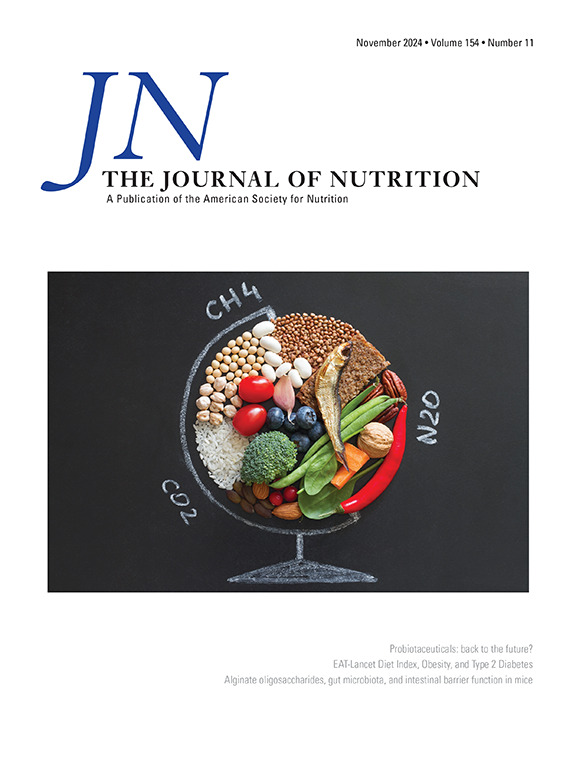Intimate Partner Violence and Women’s Dietary Diversity: A Population-Based Investigation in 8 Low- and Middle-Income Countries
IF 3.7
3区 医学
Q2 NUTRITION & DIETETICS
引用次数: 0
Abstract
Background
Intimate partner violence (IPV) poses a significant threat to the well-being of women and girls and is a highly prevalent form of gender-based violence. Evidence regarding the nutritional implications of IPV has focused primarily on intergenerational relationships with child nutrition and growth. There remains a knowledge gap regarding the association with women’s own dietary intake.
Objectives
We investigated relationships between past-year IPV (physical, emotional, and sexual) and women's dietary habits, using the Minimum Dietary Diversity for Women tool.
Methods
The data sources analyzed were the cross-sectional Demographic and Health Surveys conducted in Cambodia (2021, N = 5618), Nepal (2022, N = 4155), Sierra Leone (2019, N = 3808), Nigeria (2018, N = 8313), Tajikistan (2017, N = 4792), Cote D’Ivoire (2022, N = 3654), Kenya (2022, N = 10,717), and the Philippines (2022, N = 12,240). Utilizing multivariable generalized linear models, we assessed the overall relationship between women’s exposure to IPV and 1) the number of food groups consumed and 2) minimum dietary diversity.
Results
Our results reveal heterogeneous relationship patterns between IPV and women’s diet. Although none of the pooled estimates were significant and there were a large number of nonsignificant associations, IPV was associated with consuming a lower number of total food groups and reduced consumption of a diverse diet in Nigeria, Kenya, and the Philippines. There is evidence that in Tajikistan, physical violence relates to an increased number of food groups consumed.
Conclusions
IPV is associated with altered dietary intake patterns within certain low- and middle-income countries. The directionality of associations may depend on local food environments and food access. Further research is needed to clarify the pathways underlying these findings. These pathways may involve impacts of IPV that influence diet and food access, for example, mental health symptoms and disorders and related coping mechanisms.
亲密伴侣暴力和妇女饮食多样性:在八个低收入和中等收入国家进行的一项基于人口的调查。
背景:亲密伴侣暴力对妇女和女孩的福祉构成重大威胁,是一种非常普遍的基于性别的暴力形式。关于IPV对营养影响的证据主要集中在与儿童营养和生长的代际关系上。关于与女性自身饮食摄入量之间的关系,目前仍存在知识差距。目的:利用最小膳食多样性工具(MDD-W)调查过去一年IPV(身体、情感、性)与女性饮食习惯之间的关系。方法:数据来源为柬埔寨(2021年,N=5,618)、尼泊尔(2022年,N=4,155)、塞拉利昂(2019年,N=3,808)、尼日利亚(2018年,N=8,313)、塔吉克斯坦(2017年,N=4,792)、科特迪瓦(2022年,N=3,654)、肯尼亚(2022年,N=10,717)和菲律宾(2022年,N=12,240)的横断面人口与健康调查。利用多变量广义线性模型,我们评估了女性暴露于IPV与(i)食物种类的数量和(ii)最低饮食多样性之间的总体关系。结果:我们的研究结果揭示了IPV与女性饮食之间的异质性关系模式。尽管所有汇总的估计都不显著,而且存在大量不显著的关联,但在尼日利亚和菲律宾,IPV与食用总食物种类数量减少和多样化饮食消费减少有关。有证据表明,在塔吉克斯坦,身体暴力与所消费的食物种类增加有关。结论:IPV与某些低收入国家饮食摄入模式的改变有关。协会的方向性可能取决于当地的食物环境和食物获取途径。需要进一步的研究来阐明这些发现背后的途径。这些途径可能涉及IPV对饮食和食物获取的影响,例如,精神健康症状和障碍以及相关的应对机制。
本文章由计算机程序翻译,如有差异,请以英文原文为准。
求助全文
约1分钟内获得全文
求助全文
来源期刊

Journal of Nutrition
医学-营养学
CiteScore
7.60
自引率
4.80%
发文量
260
审稿时长
39 days
期刊介绍:
The Journal of Nutrition (JN/J Nutr) publishes peer-reviewed original research papers covering all aspects of experimental nutrition in humans and other animal species; special articles such as reviews and biographies of prominent nutrition scientists; and issues, opinions, and commentaries on controversial issues in nutrition. Supplements are frequently published to provide extended discussion of topics of special interest.
 求助内容:
求助内容: 应助结果提醒方式:
应助结果提醒方式:


